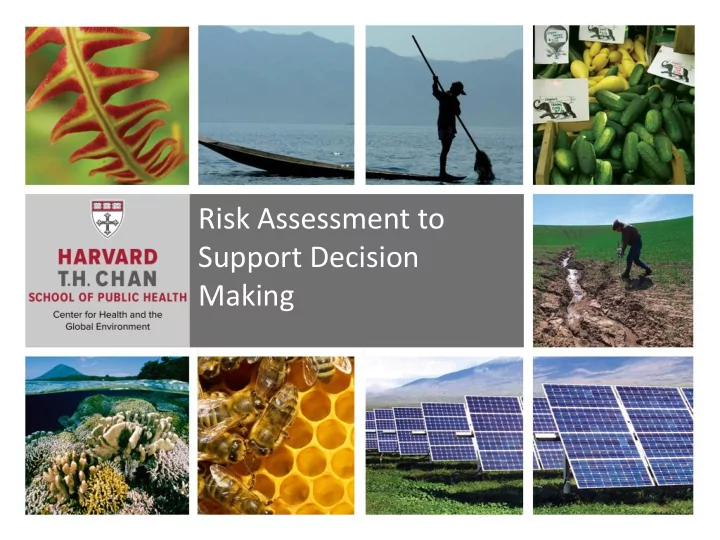

Risk Assessment to Support Decision Making
RISK ASSESSMENT TO SUPPORT DECISION MAKING Katherine von Stackelberg, ScD Center for Climate, Health and the Global Environment Harvard Center for Risk Analysis NEK Associates LTD kvon@hsph.harvard.edu 1.617.998.1037
Risk = p(Adverse Effect|Exposure, Effects) Environmental source of stressors Fate, transport, transformation Laboratory Field movement in the environment studies studies Exposure Effects (hazard) Probability of adverse ecological effect Risk
Probabilistic Approaches in Risk Assessment Most are at this value: highest frequency Frequency Source: Using Probabilistic Methods to Enhance the Role of Risk Analysis in Decision Making - Managers' Summary, 2009 Prepared by the EPA Risk Assessment Forum Working Range of Values Group Concentration- Response Function
Probabilistic Ecological Risk Assessment Probability of Probability of exceedance of a exceeding an threshold increasing magnitude 1.0 of effect 0.5 0 0 50 100 % reduction in fecundity % of population
Conceptual Model of Bt Exposure Source: Carstens et al. 2012 Transgenic Research 21:813-842
Example: Invasive Species Source: Kolar et al. 2002 Science 298(8):1233
Example of an Invasive Species Model Output: visualization of probability of Source: invasion http://www.indiana.edu/~preser ve/InvasiveSpread/model.html
Need to Understand Conditions Under Which Impacts Occur Can be downloaded from www.biorxiv.org Examples of outcomes Offtarget effects Resistance over time Efficacy – target effects
Some Examples of Risk from the Literature • The Biosafety Clearing-House (BCH) is a mechanism set up by the Cartagena Protocol on Biosafety to facilitate the exchange of information on Living Modified Organisms (LMOs) and assist the Parties to better comply with their obligations under the Protocol. Global access to a variety of scientific, technical, environmental, legal and capacity building information is provided in the six official languages of the UN. • https://bch.cbd.int/onlineconferences/ahteg_ra.shtml • An Ad Hoc Technical Expert Group (AHTEG) on Risk Assessment and Risk Management has a mandate to develop risk assessment guidelines • Review Article: What Risk Assessments of Genetically Modified Organisms Can Learn from Institutional Analyses of Public Health Risks • S. Ravi Rajan and Deborah K. Letourneau, Journal of Biomedicine and Biotechnology, Vol 2012, Article ID 203093, http://dx.doi.org/10.1155/2012/203093
Ecosystem Services: Context for Ecological Risk Source: Munns et al. 2015 Integrated Environmental Assessment and Management , DOI: 10.1002/ieam.1707
Decision Analytic Approaches for Evaluating Alternatives Risk is not just an academic exercise. There must be a decision context. Possible alternatives Criteria against which to compare alternatives
Example Metrics for Forest Ecosystem Health Metric Measurable Outcome Primary productivity Wood growth + litterfall or eddy covariance CO 2 flux Nutrient acquisition Foliar chemistry Mortality Mortality rate or standing dead trees Nutrient retention Leaching rate Water use/evapotranspiration (Precip. – streamflow) or eddy covariance H 2 O flux Resilience to moderate stress (pest, disease) Mortality after stress event Physical structure, age structure, and plant Forest inventory / canopy assessment species composition Food web structure Monitoring animal populations Soil quality Soil chemistry Biodiversity Abundance Demand (products, recreation) Market or nonmarket value Adapted from Gary Lovett’s presentation http:// nas-sites.org/dels/files/2018/01/Gary-Lovett-Presentation- Updated.pdf
Take Away 1 • All non-trivial decisions involve the potential for both good and bad outcomes – Risk applies to more than just “bad” outcomes • Decisions are informed by risk as a probability and as a perception • Risk as a probability – If we make a decision today, what are the probabilities of detrimental and beneficial outcomes in the future, and how confident are we in our estimates of these probabilities?
Take Away 2 • Risk as perception – Heuristics; Individual; Voluntary; Familiar (Known) – “Safe” • Your audience is regulatory decision and policy makers, their constituencies, and associated stakeholders • Their acceptance of “risk” will likely be driven more by perception (“safe”) than by any scientific determination (i.e., calculated probabilities) • Risk of bad outcomes to humans will almost always out-weigh those to ecological resources
Take Away 3 • New ecological assessment tools are available: – Bayesian belief networks – Weight-of-evidence analysis – Ecosystem services – Decision analytics • But: what constitutes a gene drive hazard/adverse effect? • Things could go easier if you show that: – Your technology is self- limiting (can’t “escape”) – Indirect consequences won’t happen • e.g. , loss of the target population won’t affect non -target populations or communities, etc.
Recommend
More recommend